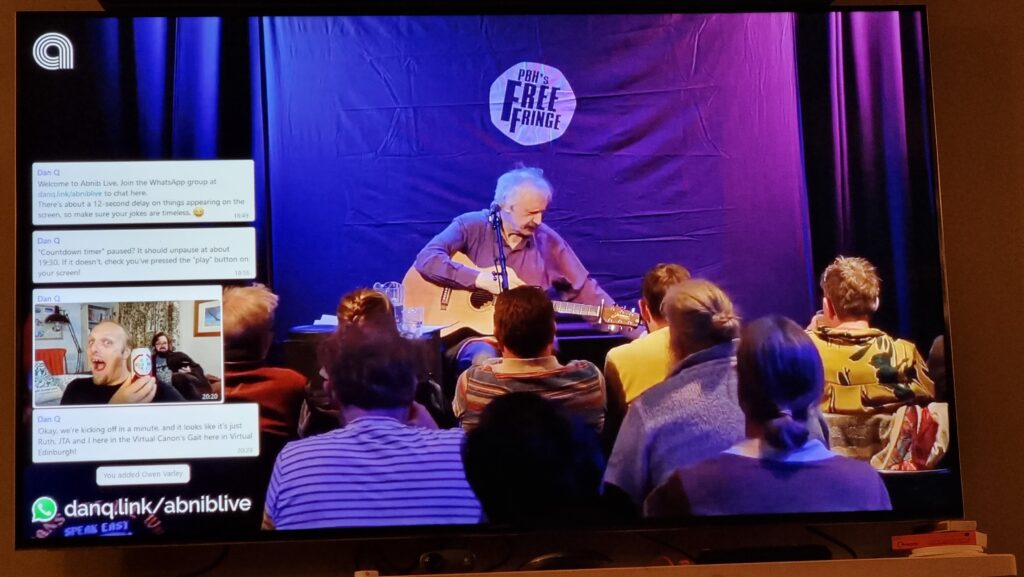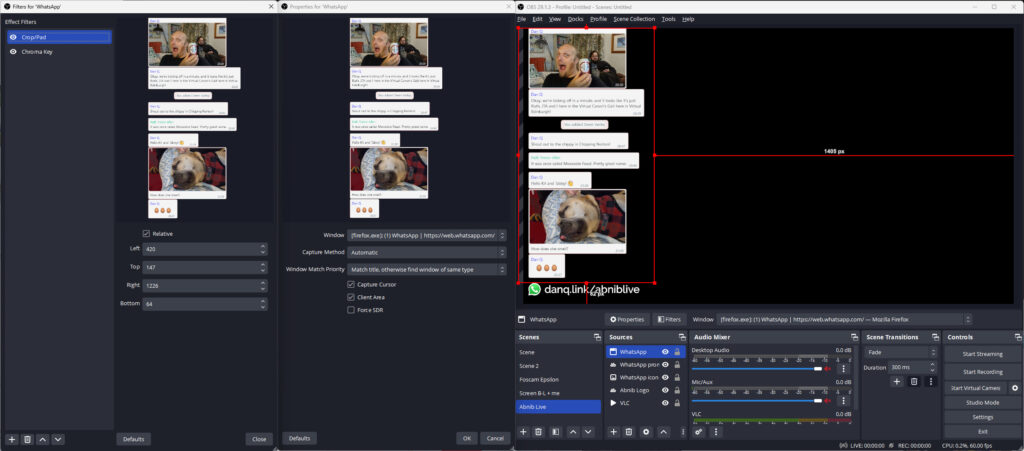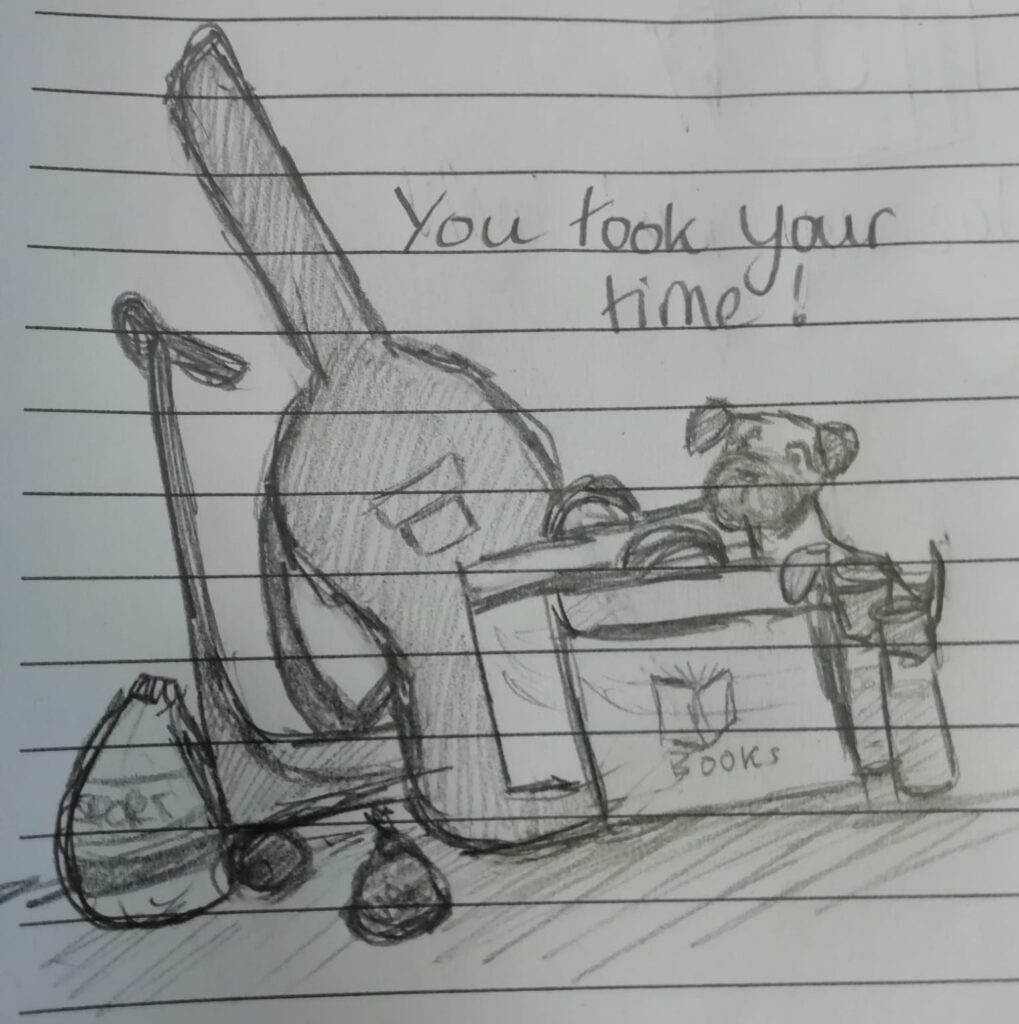This is a video version of my blog post, Length Extension Attack. In it, I talk through the theory of length extension attacks and demonstrate an SHA-1 length extension attack against an (imaginary) website.
The video can also be found on:
This post is also available as an article. So if you'd rather read a conventional blog post of this content, you can!
This is a video version of my blog post, Length Extension Attack. In it, I talk through the theory of length extension attacks and demonstrate an SHA-1 length extension attack against an (imaginary) website.
The video can also be found on:
This is a repost promoting content originally published elsewhere. See more things Dan's reposted.
After “Monty Python’s Flying Circus” ended, Graham Chapman worked with an up-and-coming young writer named Douglas Adams on a new sketch comedy show for the BBC. It was called “Out of the Trees,” and it bombed. Only one episode was made, and that aired only once, on January 10, 1976.
Once the Beeb gave up on “Out of the Trees,” they did to it what they did to so many other programs of that era: they erased it.
…
Chapman had recorded the show on one of the very earliest home videotape formats… it took two years to build a compatible player.
It’s neither Chapman nor Adams best work, and you can see how it got canned after only a pilot episode. But it’s not terrible.
But the lesson here is one about the challenge of archiving non-print media. Anything that needs a device to “play” it, whether it’s as simple as a vinyl record or as complex as a videogame, is at greater risk of being lost forever. And the faster the pace of technology moves, the more stuff gets left behind as technology moves on. Is a digital dark age looming? Are we already in it, but that won’t be known until some future date?
This weekend, I threw a Virtual Free Fringe party for some friends. The party was under-attended, but it’s fine because I got to experiment with some tech that I’d been meaning to try.

If you ever want to run something like this yourself1, here’s how I did it.
My goals were:

There were two parts to this project:
Linode offers a free trial of $100 of hosting credit over 60 days and has a ready-to-go recipe for installing Owncast, an open-source streaming server I’ve used before, so I used their recipe, opting for a 4GB dedicated server in their London datacentre: at $36/mo, there’d be no risk of running out of my free trial credit even if I failed to shut down and delete the virtual machine in good time. If you prefer the command-line, here’s the API call for that:
curl -H "Content-Type: application/json" \ -H "Authorization: Bearer $TOKEN" \ -X POST -d '{ "authorized_users": [ "[YOUR LINODE USERNAME]" ], "backups_enabled": false, "booted": true, "image": "linode/debian10", "label": "owncast-eu-west", "private_ip": false, "region": "eu-west", "root_pass": "[YOUR ROOT PASSWORD]", "stackscript_data": { "server_hostname": "[YOUR DOMAIN NAME]", "email_address": "[YOUR EMAIL ADDRESS]" }, "stackscript_id": 804172, "tags": [], "type": "g6-dedicated-2" }' https://api.linode.com/v4/linode/instances
The IP address got assigned before the machine finished booting, so I had time to copy that into my DNS configuration so the domain was already pointing to the machine before it was fully running. This enabled it to get its SSL certificate set up rightaway (if not, I’d have had to finish waiting for the DNS change to propogate and then reboot it).
Out of the box, Owncast is insecure-by-default, so I wanted to jump in and change some passwords. For some reason you’re initially only able to correct this over unencrypted
HTTP! I opted to take the risk on this server (which would only be alive for a few hours) and just configure it with this
limitation, logging in at http://mydomain:8080/admin with the default username and password (admin / abc123), changing the credentials to
something more-secure. I also tweaked the configuration in general: setting the service name, URL, disabling chat features,
and so on, and generating a new stream key to replace the default one.
Now I was ready to configure OBS Studio to stream video to my new Owncast server, which would distribute it to anybody who tuned-in.

I configured OBS Studio with a “Custom…” stream service with server rtmp://mydomain:1935/live and the stream key I chose when configuring Owncast and kicked off a test
stream to ensure that I could access it via https://mydomain. I added a VLC source4
to OBS and fed it a playlist of videos, and added some branding.
With that all working, I now needed a way to display the WhatsApp chat superimposed over the video.For this, I added a Window Capture source and pointed it at a Firefox window that was showing a WhatsApp Web view of the relevant channel. I added a Crop/Pad filter to trim off the unnecessary chrome.

Next, I used the Firefox debugger “Style Editor” to inject some extra CSS into WhatsApp Web. The class names vary frequently, so there’s no point we re-documenting all of them here, but the essence of the changes were:
.message-in, .message-out { align-items: flex-start !important; } to align them all to the left
[aria-label="You:"]::after { content: "Dan Q"; height: 15px !important; display: block; color: #00f !important; padding: 8px 0 0 8px; } to force my name to appear
even on my own messages
[aria-label^="Open chat details for "] { display: none; } to remove people’s avatars
[data-testid="msg-meta"] { display: none !important; } to remove message metadata
[data-icon] { display: none; }
I aimed where possible to exploit selectors that probably won’t change frequently, like [aria-label]s; this improves the chance that I can use the same code next time. I
also manually removed “old” messages from the channel that didn’t need to be displayed on the big screen. I wasn’t able to consistently remove “X new messages” notifications, but I’ll
probably try again another time, perhaps with the help of an injected userscript.
A little bit of a shame that more people didn’t get to see the results of this experiment, but I’m sure I’ll use the techniques I’ve learned on another ocassion.
1 Or, let’s be honest, if you’re Future Dan and you’re trying to remember how you did it in last time.
2 We were to watch a show by one of my favourite comedians Peter Buckley Hill, the man behind the Free Fringe. I’ve written about him previously… here, there, also several times in 2012 when I also helped make an official digital map of Free Fringe venues. I was especially delighted to have my photo taken with him in 2006. I might be a bit of a fanboy.
3 This could probably be adapted for any other chat system that has a web interface, so if you prefer Telegram or Slack or whatever ever, that’s fine.
4 OBS’s VLC source is just amazing: not only can you give it files, but you can give it URLs, meaning that you can set up a playlist of YouTube videos, or RTSP security camera feeds, or pretty much anything else you feel like (and have the codecs for).
The problem of “needing to be able to hear from two Bluetooth sources at once” is so real for me that I came up with a solution that I genuinely use all the time. You’re not going to like it, though.
Solution in video (no audio needed; no need to fix your headphones first!):
Originally sent as a Mastodon reply to @NireBryce@hachyderm.io.
I do not claim to have a good explanation nor excuse. See also this terrible idea from 21 years ago.
This post is also available as an article. So if you'd rather read a conventional blog post of this content, you can!
This video accompanies a blog post of the same title. The content is mostly the same; the blog post contains a few extra elements (especially in the footnotes!). Enjoy whichever one you choose.
Also available on YouTube and on Facebook.
This is a repost promoting content originally published elsewhere. See more things Dan's reposted.
I first saw this video when it was doing the rounds three years ago and was blown away. I was reminded of it recently when it appeared in a blog post about AI’s possible future role in research by Terence Eden.
I don’t even like sudoku. And if you’d told me in advance that I’d enjoy watching a man slowly solve a sudoku-based puzzle in real-time, I’d have called you crazy. But I watched it again today, for what must’ve been the third time, and it’s still magical. The artistry of puzzle creator Mitchell Lee is staggering.
If you somehow missed it the first time around, now’s your chance. Put this 25-minute video on in the background and prepare to have your mind blown.
A video, in which I rant about the challenges of carrying two-childrensworth of school gear while dragging our dog, herding somebody else’s dog, and trying to stop the kids from fighting. Some mornings it’s easy. Today… it was not. Also available on YouTube.

Full transcript of the audio (except for the ocassional snorting sounds of our noisy Frenchie as she snuffles about in the background):
The morning school run is never effortless. But some days it’s easy.
Today was not one of those days.
It’s a Wednesday. So, for some strange reason, that’s the heaviest-laden day. And so, with the eldest child on her bike and the youngest on his scooter I set off, pulling the dog, and carrying a PE kit, two book bags, two water bottles, and a guitar.
I should have realised early on that today wasn’t going to be a day that the universe smiled on me when the dog immediately ran off into a ditch to take a dump and I had to clamber down into the ditch with a poop bag to fill it.
But while I’m coming out of the ditch I discover that the youngest child has zipped off up ahead in an effort to ram into his older sister and in doing so has inevitably flipped himself over the handlebars of his scooter and is now lying, crying, in the middle of the road.
So I go over to him dragging the dog and carrying a PE kit and two book bags and two water bottles and a guitar and a bag full of poop and as best I can, carrying all those things, console him and eventually, with some encouragement he’s able to get back up and carry on walking to school, but says he can no longer scoot, so I have to carry the scooter.
Now I’m dragging a dog and carrying a poop bag and a PE kit and two water bottles and two book bags and guitar… and a scooter… and that’s when the oldest child manages to throw the chain off her bike.
Now she’s had little experience, in her defence, of the chain coming off her bike. And so she does the absolute worst thing possible which is tries to pedal as hard as possible to solve the problem which makes it much worse. By the time I get there the chain is royally snarled between some of the sprockets and their housing, so I put down the guitar and the bag of poop and I hand the lead to the younger child so that I can try to unpick the older child’s chain from her bike, getting myself covered in oil.
And that’s when I notice the commotion up ahead. There are some workmen who are rebuilding the wall outside Letterbox Cottage, and – up ahead of them – barking furiously, is a small dog. This dog is Lovey, and she belongs to a friend of ours. And she’s probably the best example of whatever the opposite of nominative determinism is. Because Lovey is a truculent little bitch. Lovey is a tiny small yappy dog who will start a fight with other dogs, try to see off workmen (which is what she’s doing at the time), and she’ll bark at passing cars. And right now she’s running free, unattended, in the middle of the road. And one of the workmen says to me, “Oh, do you know who’s dog that is?” and I have to admit that yes, I do.
So, dragging our dog and carrying a PE kit and two book bags and two water bottles, a guitar, a scooter, and a bag of poop, I have to help round up this lost dog, who – if it gets too close to our dog will start a fight – and get it back to the house where it lives.
So the younger child and I manage to succeed in our mission and return this lost dog and get back on our way to school and it’s there that we finally catch up with the older child who’s gotten bored and cycled ahead. And when we catch up to the older child with me dragging the dog and carrying a PE kit and two book bags and two water bottles and a guitar and a scooter and a bag of poop… she looks up at me and says, “Ugh! You took your time!”
Suffice to say, it’s a good job I Iove those children.
(Just want the instructions? Scroll down.)
A year and a half ago I came up with a technique for intercepting the “shuffle” operation on jigsaw website Jigidi, allowing players to force the pieces to appear in a consecutive “stack” for ludicrously easy solving. I did this partially because I was annoyed that a collection of geocaches near me used Jigidi puzzles as a barrier to their coordinates1… but also because I enjoy hacking my way around artificially-imposed constraints on the Web (see, for example, my efforts last week to circumvent region-blocking on radio.garden).
My solver didn’t work for long: code changes at Jigidi’s end first made it harder, then made it impossible, to use the approach I suggested. That’s fine by me – I’d already got what I wanted – but the comments thread on that post suggests that there’s a lot of people who wish it still worked!2 And so I ignored the pleas of people who wanted me to re-develop a “Jigidi solver”. Until recently, when I once again needed to solve a jigsaw puzzle in order to find a geocache’s coordinates.
Rather than interfere with the code provided by Jigidi, I decided to take a more-abstract approach: swapping out the jigsaw’s image for one that would be easier.
This approach benefits from (a) having multiple mechanisms of application: query interception, DNS hijacking, etc., meaning that if one stops working then another one can be easily rolled-out, and (b) not relying so-heavily on the structure of Jigidi’s code (and therefore not being likely to “break” as a result of future upgrades to Jigidi’s platform).
Watch a video demonstrating the approach:
It’s not as powerful as my previous technique – more a “helper” than a “solver” – but it’s good enough to shave at least half the time off that I’d otherwise spend solving a Jigidi jigsaw, which means I get to spend more time out in the rain looking for lost tupperware. (If only geocaching were even the weirdest of my hobbies…)
To do this yourself and simplify your efforts to solve those annoying “all one colour” or otherwise super-frustrating jigsaw puzzles, here’s what you do:
The replacement image has the following characteristics that make it easier to solve than it might otherwise be:
To solve the jigsaw, start by grouping colours together, then start combining those that belong in the same column (based on the second digit on the piece). Join whole or partial columns together as you go.
I’ve been using this technique or related ones for over six months now and no code changes on Jigidi’s side have impacted upon it at all, so it’s probably got better longevity than the previous approach. I’m not entirely happy with it, and you might not be either, so feel free to fork my code and improve it: the legiblity of the numbers is sometimes suboptimal, and the colour banding repeats on larger jigsaws which I’d rather avoid. There’s probably also potential to improve colour-recognition by making the colour bands span the gaps between rows or columns of pieces, too, but more experiments are needed and, frankly, I’m not the right person for the job. For the second time, I’m going to abandon a tool that streamlines Jigidi solving because I’ve already gotten what I needed out of it, and I’ll leave it up to you if you want to come up with an improvement and share it with the community.
1 As I’ve mentioned before, and still nobody believes me: I’m not a fan of jigsaws! If you enjoy them, that’s great: grab a bucket of popcorn and a jigsaw and go wild… but don’t feel compelled to share either with me.
2 The comments also include asuper-helpful person called Rich who’s been manually solving people’s puzzles for them, and somebody called Perdita who “could be my grandmother” (except: no) with whom I enjoyed a conversation on- and off-line about the ethics of my technique. It’s one of the most-popular comment threads my blog has ever seen.
This is a repost promoting content originally published elsewhere. See more things Dan's reposted.
This was a delightful vlog. It really adds personality to what might otherwise have been a story only about technology and history.
I subscribed to Codex’s vlog like… four years ago? He went dark soon afterwards, but thanks to the magic of RSS, I got notified as soon as he came back from his hiatus.
The week before last I had the opportunity to deliver a “flash talk” of up to 4 minutes duration at a work meetup in Vienna, Austria. I opted to present a summary of what I’ve learned while adding support for Finger and Gopher protocols to the WordPress installation that powers DanQ.me (I also hinted at the fact that I already added Gemini and Spring ’83 support, and I’m looking at other protocols). If you’d like to see how it went, you can watch my flash talk here or on YouTube.
If you love the idea of working from wherever-you-are but ocassionally meeting your colleagues in person for fabulous in-person events with (now optional) flash talks like this, you might like to look at Automattic’s recruitment pages…
The presentation is a shortened, Automattic-centric version of a talk I’ll be delivering tomorrow at Oxford Geek Nights #53; so if you’d like to see it in-person and talk protocols with me over a beer, you should come along! There’ll probably be blog posts to follow with a more-detailed look at the how-and-why of using WordPress as a CMS not only for the Web but for a variety of zany, clever, retro, and retro-inspired protocols down the line, so perhaps consider the video above a “teaser”, I guess?
This checkin to geohash 2023-01-02 51 -1 reflects a geohashing expedition. See more of Dan's hash logs.
Muswell Hill, Piddington, Oxfordshire
I bundled the dog into the car and drove out to Piddington, a couple of kilometres North of the hashpoint. Cherwell Council advertise a circular walk that seems to circle from the village (which looked like a good place to park) up to Muswell Hill, the summit of which is near the hashpoint.
She and I walked through Piddington, past the church, and up onto the path. A soggy kilometre or so later we quickly discovered that this was going to be more-challenging than I’d anticipated. We quickly got bogged down in a flooded field and needed to double-back. With my socks already soaking wet and the dog in a similar condition, we found a different route that looped around the entire hill and through an alpaca farm (or were they llamas?), then we worked our way up the South face of the hill, over the summit, and down to the hashpoint. We got there at 11:00 UTC, took a quick look around and pulled the closest thing a dog can manage to a silly grin, and then hacked our way back (by road) to Piddington for the drive home and some dry clothes.

Also available on YouTube.
This checkin to geohash 2022-10-24 51 -1 reflects a geohashing expedition. See more of Dan's hash logs.
Wharf Stream Way, Eynsham. I’ve visited this circular footpath many times to walk the dog or to take the children to swim in the river.
I hope to cycle/walk to the GZ about lunchtime? I’ve an opportunity to pass nearby the GZ between other errands this morning!
I was excited to see this spot pop up on my radar, because it’s a lovely meadow that I’ve ocassionally walked my dog in, within comfortable cycling distance of my house. As it happened, I had an even easier route here because a drive this morning to drop the kids off at a half-term activity took me “close enough” to be worth stopping and walking from there.
I parked at The Talbot Inn, just West of the Swinford Toll Bridge (a bizzare old bridge that, for weird historical reasons, continues to use human operators to charge 5 pence per car to cross, which surely cannot be cost-effective!). From here, there’s a footpath along the back of the Seimens buildings in the nearby light industrial estate which eventually comes out into the Wharf Stream Way circular walk. It was pretty damp out here today and I quickly regretted my choice of light trousers which would have been fine to drive the kids to their camp and back but wasn’t really a good choice for stomping across the long grass of a damp meadow. Some way across I disturbed some grazing deer, but ultimatey it was following a deer-trodden trail that eventually provided the best route to the GZ.
I reached the GZ at 09:19, took a selfie, and then turned around to go and get to work. I also shot a video covering the whole expedition which is presented, unedited, below.
My GPSr kept a tracklog; note that this was an “on the way” stopoff so the start and end point isn’t the same!
This post is also available as an article. So if you'd rather read a conventional blog post of this content, you can!
This video accompanies a blog post of the same title. The content is basically the same – if you prefer videos, watch this video. If you prefer blog posts, go read the blog post. You might also like to play with my Mastermind solver or view the source code.
This post is also available as an article. So if you'd rather read a conventional blog post of this content, you can!
This video accompanies a blog post of the same title. The content is basically the same – if you prefer videos, watch this video. If you prefer blog posts, go read the blog post.